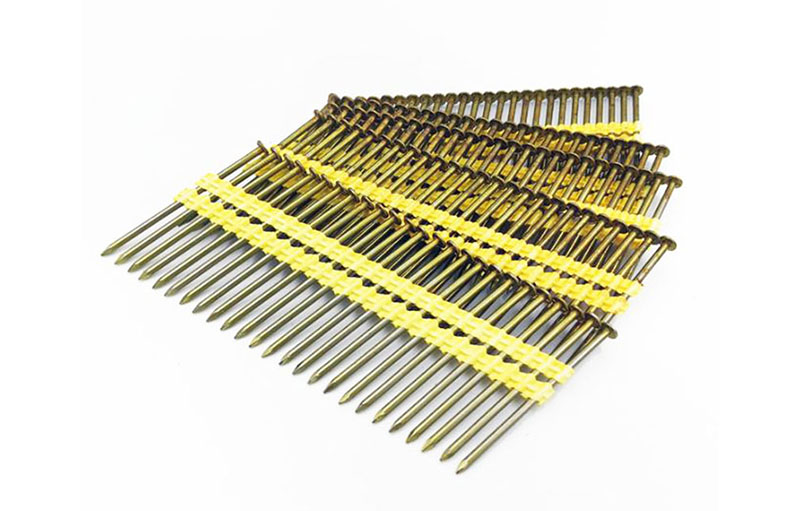Plastic Collated Nails: An Efficient Helper for Decoration and Construction
In fields such as construction, decoration, and furniture manufacturing, nails are indispensable fastening tools. With the development of technology, traditional single nails have gradually been replaced by more efficient collated nails. Among them, plastic collated nails have become the first choice for many construction scenarios due to their unique advantages. This article will detail the characteristics, application scope, purchasing skills, and usage precautions of plastic collated nails, helping you easily grasp the core information of this practical tool.
I. What Are Plastic Collated Nails? A Quick Understanding of Their Basic Definition and Structure
Simply put, plastic collated nails are a combination of multiple nails of the same specification, arranged at equal intervals and fixed in a row using plastic connectors. The biggest difference between them and ordinary single nails lies in the "row design" - they can be used with special nail guns, greatly improving construction efficiency.
In terms of structure, plastic collated nails mainly consist of two parts:
Nail Body: The core load-bearing component. Common materials include metal (such as Q235 steel, SS304 stainless steel, copper) and pure plastic (such as polypropylene PP, polyethylene PE). Metal nail bodies have high strength and are suitable for load-bearing scenarios; pure plastic nail bodies focus on corrosion resistance and insulation, making them suitable for special environments.
Plastic Connector: The key part that fixes individual nails into a row. Usually made of high-strength engineering plastics, it breaks naturally when the nail gun fires, without affecting the fixing effect of the nails. At the same time, it ensures that the nails are neatly arranged during use to avoid deviation.
II. The 4 Core Advantages of Plastic Collated Nails - Why Are They More Popular Than Ordinary Nails?
Compared with traditional single nails (such as round nails and iron nails), plastic collated nails have significant improvements in construction efficiency, application scenarios, and usage effects. The specific advantages are as follows:
1. Doubled Efficiency: Compatible with Nail Guns, No More "Manual Hammering"
The core advantage of plastic collated nails lies in their "compatibility with nail guns". Ordinary nails need to be hammered one by one manually, which is not only time-consuming and labor-intensive but also prone to problems such as nail skewing and hand injuries. However, plastic collated nails can be directly loaded into pneumatic nail guns or electric nail guns, and quickly fired through mechanical power. They can complete dozens of nailing operations per minute, which is especially suitable for large-area construction (such as ceiling installation, wooden box packaging, and fence construction), saving more than 50% of construction time.
2. Wide Application Scope: Covering Multiple Fields from Decoration to Industry
Plastic collated nails come in various specifications (optional angles, lengths, and materials) and can meet the fastening needs of different scenarios:
Decoration and Renovation: Used for fixing wall gypsum boards, installing baseboards, and splicing wooden wall panels. The plastic connectors will not damage the decorative surface, avoiding obvious marks.
Furniture Manufacturing: When assembling wardrobes, desks, and sofa frames, metal plastic collated nails have high strength, which can ensure the stability of the furniture structure. Moreover, using them in rows can reduce the number of nail holes and improve aesthetics.
Outdoor Construction: Plastic collated nails made of stainless steel or pure plastic are resistant to rainwater and corrosion, making them suitable for building wooden fences, outdoor floors, and pavilions. They are not easy to rust after long-term use.
Special Scenarios: Pure plastic collated nails have good insulation properties and can be used for fixing around electrical equipment (such as wire sleeves and insulation boards) to avoid the risk of electric conduction. They can also be used in industrial fields such as shipbuilding and CNC wood processing, adapting to high-precision construction.
3. More Stable Fixing: Design Details Enhance Gripping Force
High-quality plastic collated nails usually have special treatments on the nail body:
The surface of the nail rod is designed with annular patterns, threads, or anti-slip grooves. After being driven into materials such as wood and plastic, it can enhance friction with the base material and prevent the nail from loosening.
Most metal nail bodies undergo galvanization (electro-galvanization, hot-dip galvanization) and heat treatment, which not only improve rust resistance but also increase the hardness of the nail body, making it not easy to bend and break when driven into hard wood.
4. Lightweight and Easy to Carry, Safer to Use
Plastic collated nails are packaged in rows with a regular shape. Compared with scattered single nails, they are more convenient to store and transport, reducing the loss of nails during construction. At the same time, when used with a nail gun, there is no need to directly touch the tip of the nail with hands, which reduces the risk of scratches and injuries caused by nails and ensures higher safety.
III. How to Choose the Specification of Plastic Collated Nails? Focus on These 3 Key Parameters
There are various specifications of plastic collated nails on the market. Choosing the wrong one may lead to reduced construction efficiency or even failure of fixing. Focus on the following 3 parameters when purchasing:
1. Angle: Compatibility with Nail Guns Is the Key
The angle of plastic collated nails refers to the included angle formed by the arrangement of nails. Common specifications are 17°, 21°, 28°, and 34°. Different angles correspond to nail guns of different brands and models (for example, 21° plastic collated nails are compatible with nail guns of brands such as Hitachi and DEWALT). Before purchasing, you need to confirm the compatible angle of your nail gun to avoid "buying the wrong one and being unable to use it".
2. Nail Length and Wire Diameter: Choose According to the Thickness of the Base Material
Nail Length: Usually ranges from 50mm to 160mm. The thicker the base material, the longer the nail you need to choose (for example, when fixing a 5cm thick wooden beam, you can choose a plastic collated nail with a length of 70mm-80mm to ensure that the nail can penetrate the base material and go deep into the fixed surface).
Wire Diameter: That is, the diameter of the nail body. Common specifications are 2.5mm-4.6mm. The thicker the wire diameter, the higher the strength of the nail, which is suitable for load-bearing scenarios (such as choosing a wire diameter of more than 4.0mm for fixing furniture frames); for lightweight fixing (such as gypsum boards), a wire diameter of 2.5mm-3.0mm can be selected.
3. Material and Surface Treatment: Adapt to the Usage Environment
Humid Environments (such as bathrooms, outdoors): Choose stainless steel (SS304/SS316) or pure plastic materials to avoid rust.
Ordinary Dry Environments (such as indoor decoration): Choose Q235 steel or 45# steel materials for high cost-effectiveness.
Scenarios with High-Precision or Aesthetic Requirements: Choose plastic collated nails that have undergone polishing treatment. The nail heads are flat, reducing construction marks.
IV. Precautions for Using Plastic Collated Nails: Avoid Mistakes and Improve Construction Effect
Using plastic collated nails correctly can extend the service life of tools and ensure the fixing effect. Pay attention to the following 3 points when using:
Check the Compatibility Between the Nail Gun and Plastic Collated Nails in Advance: Before loading the plastic collated nails, confirm that the angle of the nail gun and the size of the nail slot match the plastic collated nails. Avoid forcing them to be loaded, which may cause the nails to deform or the nail gun to jam.
Adjust the Nail Gun Force According to the Base Material: Different base materials have different hardness (such as soft wood, hard wood, plastic). It is necessary to adjust the striking force of the nail gun to avoid the nail not being fully driven in due to too small force, or the base material cracking due to too large force.
Do a Good Job in Safety Protection: When using a nail gun, wear protective glasses (to prevent debris from splashing) and gloves (to avoid hand scratches). Do not fire at people or flammable items. After construction, turn off the power or air source of the nail gun in time.
V. Summary: Plastic Collated Nails - An Efficient and Practical Modern Construction Tool
Whether you are a professional decorator or a DIY enthusiast, plastic collated nails are a good helper to improve construction efficiency and ensure fixing effect. Their row design is compatible with nail guns, which can greatly save time; the various specifications and materials can meet the needs of various scenarios from indoor decoration to outdoor construction. As long as you master the correct purchasing methods and usage skills, you can make plastic collated nails play the greatest value in construction.
If you are preparing for decoration, furniture production, or outdoor construction, you may wish to choose suitable plastic collated nails according to your actual needs and experience the convenience of "efficient construction"!



 Send Email
Send Email